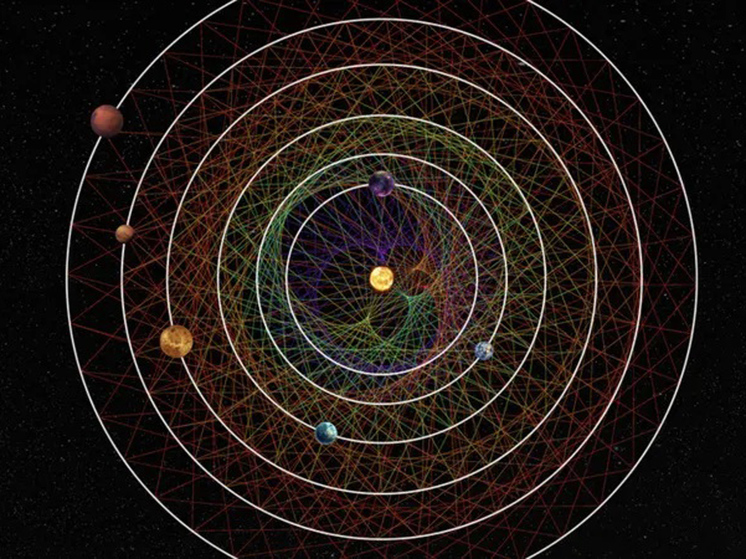Astronomers have found a “pristine” six-planet solar system
Astronomers have discovered a nearby six-planet solar system with an “untouched configuration.” Scientists have used two different exoplanet detection satellites to solve a cosmic mystery and uncover a rare family of six planets located about 100 light-years from Earth. This discovery could help researchers uncover the secrets of planet formation.

Six exoplanets orbit a bright sun-like star called HD110067, which is located in the constellation Coma Berenices in the northern sky. Larger than Earth but smaller than Neptune, the planets belong to a little-studied class called sub-Neptunians, which typically orbit sun-like stars in the Milky Way. And the planets, designated b through g, orbit the star in a celestial dance known as orbital resonance, CNN reports.
According to a study published Wednesday in the journal Nature, there are noticeable patterns in the way planets complete their orbits and exert a gravitational influence on each other. For every six orbits completed by planet b, the closest planet to the star, the outermost planet g completes one.
When planet c makes three orbits around a star, planet d makes two, and when planet e makes four orbits, planet f makes three orbits.
This harmonic rhythm creates a resonant chain in which all six planets align every several revolutions, CNN explains.
What makes this planetary family an unusual find is that little has changed since the system formed more than 1 billion years ago, and the discovery could shed light on the evolution of planets and the origins of the predominant sub-Neptunian objects in our home galaxy.
Researchers first took notice of the star system in 2020 when NASA's Transiting Exoplanet Survey Satellite, or TESS, detected dips in the brightness of HD110067. Diminishing starlight often indicates the presence of a planet passing between its host star and an observing companion as the planet moves along its orbital path. Detecting these dips in luminosity, known as the transit method, is one of the main strategies scientists use to identify exoplanets using ground-based and space-based telescopes.
Astronomers determined the orbital periods of two planets around a star from these 2020 data . Two years later, TESS observed the star again, and the data obtained showed different orbital periods of these planets.
When the data sets didn't match, astronomer and study lead author Raphael Luc and some of his colleagues decided to take another look at the star using a different satellite—the European Space Agency's signature exoplanet satellite, or Cheops. While TESS is used to observe fragments of the night sky for short observations, Cheops observes one star at a time.
“We looked for signals among all the potential periods that these planets could have,” says Raphael Luke is a graduate student in the Department of Astronomy and Astrophysics at the University of Chicago.
According to him, the data collected by Cheops helped the team solve the “detective story” begun by TESS. Cheops was able to determine the presence of a third planet in the system, which was critical to confirming the orbital periods of the other two planets, as well as their rhythmic resonance.
When the team matched the remaining unexplained TESS data with the Cheops observations, they discovered three other planets , orbiting a star. Subsequent observations using ground-based telescopes confirmed the presence of planets.
The dedicated time Cheops spent observing the star helped astronomers iron out conflicting signals from the TESS data to determine how many planets crossed in front of the star, and the resonance of their orbits.
“Cheops gave us this resonant configuration that allowed us to predict all other periods. Without this discovery with the help of Cheops, this would have been impossible,” said Luke.
The closest planet takes just over nine Earth days to complete a revolution around its star, while the most distant one takes about 55 days. All planets orbit their star faster than Mercury, which takes 88 days to complete one orbit around the Sun.
Given how close they are to HD110067, the planets likely have high average temperatures similar to Mercury and Venus, in the range from 167 to 527 degrees Celsius.
The formation of planetary systems like our own Solar System can be a tumultuous process. While astronomers believe that planets tend to initially form in resonance around stars, the gravitational influence of massive planets or a collision with a passing star or other celestial body can upset the harmonic balance.
This discovery is the second case. , when Cheops helped discover a planetary system with orbital resonance. The first of these, known as TOI-178, was announced in 2021.
“As our scientific team says: Cheops makes extraordinary discoveries commonplace. Of only three known resonant systems with six planets, this is the second one discovered by Cheops, and in just three years of operation,” says Maximilian Günther, ESA Cheops project scientist.
According to the study authors, the system could also be used to study how sub-Neptunian objects form. While sub-Neptunian objects are common in the Milky Way galaxy, they do not exist in our own Solar System. And there's no consensus among astronomers about how these planets form or what they're made of, so an entire system of sub-Neptunian objects could help scientists learn more about their origins, Luke said. Many exoplanets have been discovered orbiting dwarf stars that are much cooler and smaller than our Sun, such as the famous TRAPPIST-1 system and its seven planets announced in 2017. While the TRAPPIST-1 system also has a resonant chain, the weakness of the host star makes observations difficult.
But HD110067, which has 80% the mass of our Sun, is the brightest known star with more than four planets in orbit, making the system much easier to observe, CNN notes.
Initial data on the planets' masses suggests that some of them have dense, hydrogen-rich atmospheres, making them ideal study subjects for the James Webb Space Telescope. Because starlight penetrates planetary atmospheres, Webb can be used to determine the composition of each world.
“The sub-Neptunian planets of the HD110067 system appear to have low mass, suggesting they may be rich in gas or water. Future observations, for example with the James Webb Space Telescope, of the atmospheres of these planets could determine whether the planets have rocky or water-rich internal structures,” study co-author Jo Ann Egger, a doctoral student in astrophysics at the University of Bern, said in a statement.






















































Свежие комментарии